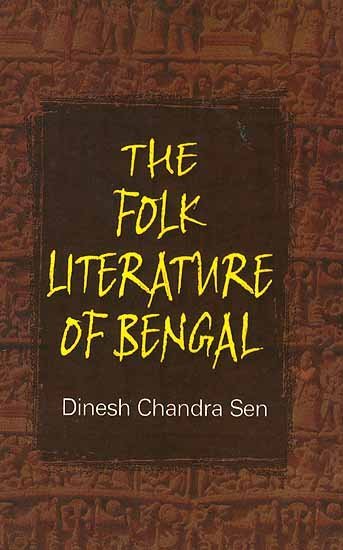Folk Tradition of Bengal (and Rabindranath Tagore)
by Joydeep Mukherjee | 2018 | 49,317 words | ISBN-10: 8186036989 | ISBN-13: 9788186036983
An English study regarding the Folk Tradition of Bengal and its influence on Rabindranath Tagore—an important Bengali polymath from the 19th century who excelled in philosophy, arts (painting), literature and music. This research tries to initiate the semantic aspect of “folk” through the help of various dictionaries....
Chapter 5.1 - Mysterious Meeting between two Giants
This topic ensues doubts, confusions and confrontation and creates a maze. Critics are genuinely divided into two groups on the basis of yes or no though unable to affirm yes or no.
Jaladhar Sen first tries shape the abstract doubts and confusions in his book Kangal Jibani:
Shiniachi, kabibar shrijukta Rabindranath thajurer Shilaidaher khuti te Lalon Fakir akbar gan koria sokol k montra mukdho koriya rakhiyachilen|
Translation:
“It is heard that Lalon Fakir made people awestruck when he sang from morning to afternoon in Tagore’s hut in Shilaidaha.”
But Sachindranath Adhikary tried to trace the topic in his essay Kabimilan. Immediately in the next year (Bengali 1352), he wrote a short story titled–Pallir Manish Rabindranath (Rabindranath, a man of village). The research from the extracts insinuates that the story is based on the conversation between these two giants. Then there is an unexpected twist.
The research probes into it and drags the vital point that after a long time the writer of the Book understood his mistake and shared the same through a letter to Abul Hasan Chowdhury–(8/11/1970):
Laloner mrityu 1890 saler 17 october 116 bochor boyose. Rabindranath oi somoye jamidarir bhar panni; tai sakkhat hoini bolei dhpra jete pare|
Translation:
“Lalon died on 17th October in 1890 when Tagore was not in charge of Jamindar.”
Therefore, they did not meet.
Except that the research can consider the comments of Gosain Gopal in Gopal Gitabali:
... Sadhak Lalon Sain Bohu sadhu o Darbesh Thakurer sohit dekha korite asiten| kobi Rabindranath Lalon Sain k valobasiten o tar gan shrobon koriten|
Translation:
“Lalon along with many sadhus and Darbesh Thakur used to come to Tagore and they used to sing.”
Side by side he makes a contradictory statement with a reference to Muhammad Mansuruddin’s Janashruti:
Eta akta aschorjer byapar Rabindranath er sathe Laloner dekha sakkhat hoyechilo kina tar kono nischit khobor pawa jaina|
Translation:
“It is very surprising that there is no authentic information regarding the encounter between Rabindranath and Lalon Fakir”.
Sukumar Sen was quite emphatic when he said:
Sadhana chalaibar kale Rabindranath Lalon Fakir o Andha Boshtomi r moto kichu Baul-Vaishanv Darbesher sonssporshe esechilen|
Translation:
“During his sadhana Tagore came in contact with so many Bauls like Lalon Fakir and Andha Boshtomi”.
The research can included valuable concerns of Binay Ghosh:
1884-85 sale Baul ganer songrohoti hate porar por jokhon lokosahityer dike tar drishti akorshan holo, tar du tin bochorer modhyei mone hoi, Shilaidoher bikkhato Baul Lalon Fakir er sathe tar sakkhat hoyechilo|
Translation:
“He realized the value of Loksahitya after geeting the copy of Baul Collection. After two or three years, may be, Tagore happened to meet renowned Lalon Fakir in Shilaidaha.”
However, it can be stated the researchers or critics were under over influence of Tagore changed their opinions when they realised it to be groundless and baseless. The research can include Hiranmoy Bondapadhyay saying in one of his interviews that these all are opinions not facts, Annadashankar Roy commenting the entire discussion is beyond any proof, Asit Bondapadhyay, a renowned scholar and writer of Bangla Sahityer Itihas opining they never met.
Finally, Saiyad Murtaja Ali emphatically repeats:
Kau kau likhechen j Lalon Fakir er sathe Rabindranath er dekha shone hoto|
kintu Rabindranath er sathe Lalon Fakir er kono biswasjogyo proman ney|
Translation:
“Though people say they used to meet and talk, it is hypothetical without any reliable proof”.
After all the research wants to convey that there are some hints in the writings of Rabindranath Tagore himself through these are very oblique and intricate.
In the introductory part of ‘Haramoni’, he wrote:
Shilaidahe jokhon chilam, Baul doler sathe amr sorbodai dekha sakkhat o alap alochana hoto|
Translation:
“I used to talk with different group of Bauls when I was in Shilaidaha”.
It is totally uncertain and risky as well to think that Lalon was there as a member of such a group.
The conversation between Tagore and Kalimohon Ghosh, there is a hidden interface yet blurred:
Tumi to dekhecho Lalon Shah Fakir er sishyo der sathe amr ki rokom alap jomto|
Translation:
“You know only how much I love to talk to and interact with the disciples of Lalon Fakir”.
Here again no surety can be interred whether Lalon was present with his disciples. Rather tone of Tagore indicates among or through his disciples Tagore was successful to tease him. Later on, in several lectures he mentioned the names of Gagan Harkara and others but not for a single time he has mentioned the name of Lalon Fakir. Now at this stage it is very obvious for Tagore to be exultant to place his name if he could have met him. On the other hand, when he started visiting Shilaidaha due to Jamindari responsibility during 1889, the provision to meet Lalon was extremely high but still lack of any proof unsettles any further discussion. Therefore, the research also fails to draw any line final line regarding such historic confluence. This is why the research considers the impression of Tagore as an instance of ‘indirect influence’.
